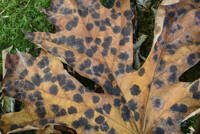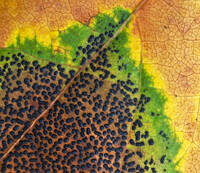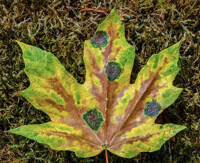Distribution: Broad North America, introduced to Europe
Substrate: Extremely common on maples in both forest and urban areas
Conservation Status: Not of concern
In our region, Rhytisma punctatum is extremely common on maples, especially bigleaf maple, in both forest and urban areas. Around mid-August, islands of small black spots (structures that will produce sexual spores in the following spring) surrounded by yellowish tissue develop on the living leaves. Later in fall when the leaves have turned mostly golden and fallen, the “tar spots” can be seen surrounded a circle of green tissue that remains photosynthetic long after the leaves have fallen to the ground. The fungus over-winters in the dead leaf and, in spring, releases spores that are transported by winds to infect new young leaves. Two other species---R. americanum Hudler & Banik, and R. acerinum (Persoon) Fries---also occur in our region. All three occur widely in North America and the latter is thought to have been introduced from Europe.
PNW Herbaria: Specimen records of Rhytisma punctatum in the Consortium of Pacific Northwest Herbaria database.
CalPhotos: Rhytisma punctatum photos.










